Bofei Gao
CodeElo: Benchmarking Competition-level Code Generation of LLMs with Human-comparable Elo Ratings
Jan 03, 2025Abstract:With the increasing code reasoning capabilities of existing large language models (LLMs) and breakthroughs in reasoning models like OpenAI o1 and o3, there is a growing need to develop more challenging and comprehensive benchmarks that effectively test their sophisticated competition-level coding abilities. Existing benchmarks, like LiveCodeBench and USACO, fall short due to the unavailability of private test cases, lack of support for special judges, and misaligned execution environments. To bridge this gap, we introduce CodeElo, a standardized competition-level code generation benchmark that effectively addresses all these challenges for the first time. CodeElo benchmark is mainly based on the official CodeForces platform and tries to align with the platform as much as possible. We compile the recent six months of contest problems on CodeForces with detailed information such as contest divisions, problem difficulty ratings, and problem algorithm tags. We introduce a unique judging method in which problems are submitted directly to the platform and develop a reliable Elo rating calculation system that aligns with the platform and is comparable with human participants but has lower variance. By testing on our CodeElo, we provide the Elo ratings of 30 existing popular open-source and 3 proprietary LLMs for the first time. The results show that o1-mini and QwQ-32B-Preview stand out significantly, achieving Elo ratings of 1578 and 1261, respectively, while other models struggle even with the easiest problems, placing in the lowest 25 percent among all human participants. Detailed analysis experiments are also conducted to provide insights into performance across algorithms and comparisons between using C++ and Python, which can suggest directions for future studies.
Language Models can Self-Lengthen to Generate Long Texts
Oct 31, 2024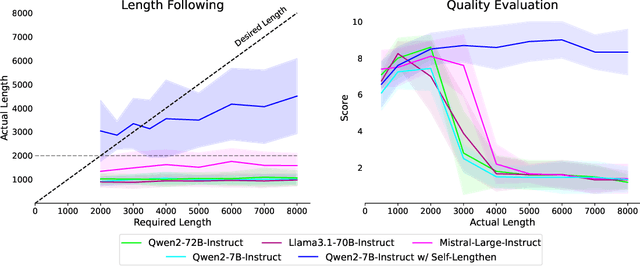
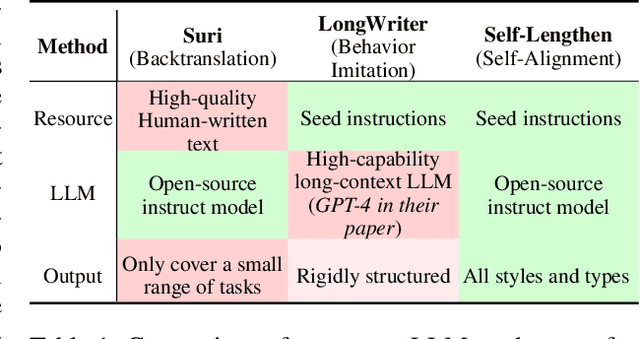
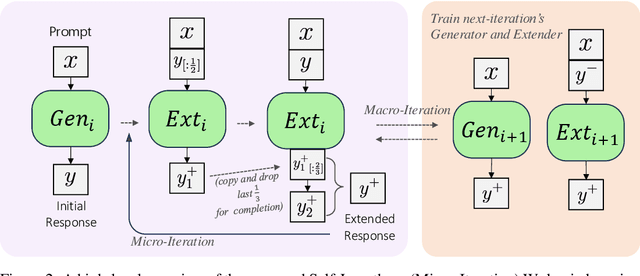
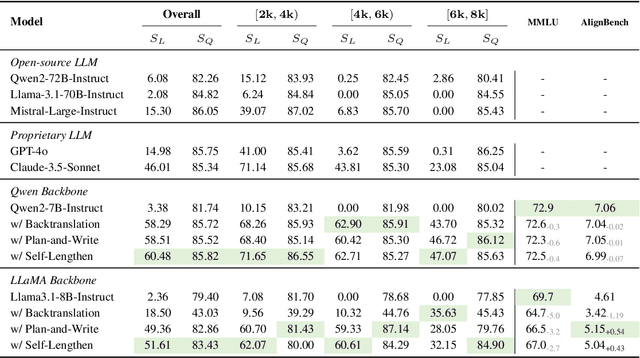
Abstract:Recent advancements in Large Language Models (LLMs) have significantly enhanced their ability to process long contexts, yet a notable gap remains in generating long, aligned outputs. This limitation stems from a training gap where pre-training lacks effective instructions for long-text generation, and post-training data primarily consists of short query-response pairs. Current approaches, such as instruction backtranslation and behavior imitation, face challenges including data quality, copyright issues, and constraints on proprietary model usage. In this paper, we introduce an innovative iterative training framework called Self-Lengthen that leverages only the intrinsic knowledge and skills of LLMs without the need for auxiliary data or proprietary models. The framework consists of two roles: the Generator and the Extender. The Generator produces the initial response, which is then split and expanded by the Extender. This process results in a new, longer response, which is used to train both the Generator and the Extender iteratively. Through this process, the models are progressively trained to handle increasingly longer responses. Experiments on benchmarks and human evaluations show that Self-Lengthen outperforms existing methods in long-text generation, when applied to top open-source LLMs such as Qwen2 and LLaMA3. Our code is publicly available at https://github.com/QwenLM/Self-Lengthen.
Aligning CodeLLMs with Direct Preference Optimization
Oct 24, 2024Abstract:The last year has witnessed the rapid progress of large language models (LLMs) across diverse domains. Among them, CodeLLMs have garnered particular attention because they can not only assist in completing various programming tasks but also represent the decision-making and logical reasoning capabilities of LLMs. However, current CodeLLMs mainly focus on pre-training and supervised fine-tuning scenarios, leaving the alignment stage, which is important for post-training LLMs, under-explored. This work first identifies that the commonly used PPO algorithm may be suboptimal for the alignment of CodeLLM because the involved reward rules are routinely coarse-grained and potentially flawed. We then advocate addressing this using the DPO algorithm. Based on only preference data pairs, DPO can render the model rank data automatically, giving rise to a fine-grained rewarding pattern more robust than human intervention. We also contribute a pipeline for collecting preference pairs for DPO on CodeLLMs. Studies show that our method significantly improves the performance of existing CodeLLMs on benchmarks such as MBPP and HumanEval.
Omni-MATH: A Universal Olympiad Level Mathematic Benchmark For Large Language Models
Oct 10, 2024


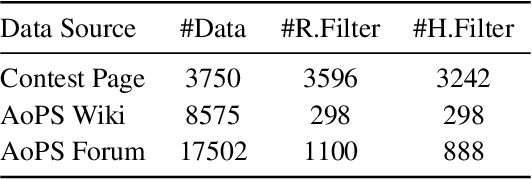
Abstract:Recent advancements in large language models (LLMs) have led to significant breakthroughs in mathematical reasoning capabilities. However, existing benchmarks like GSM8K or MATH are now being solved with high accuracy (e.g., OpenAI o1 achieves 94.8% on MATH dataset), indicating their inadequacy for truly challenging these models. To bridge this gap, we propose a comprehensive and challenging benchmark specifically designed to assess LLMs' mathematical reasoning at the Olympiad level. Unlike existing Olympiad-related benchmarks, our dataset focuses exclusively on mathematics and comprises a vast collection of 4428 competition-level problems with rigorous human annotation. These problems are meticulously categorized into over 33 sub-domains and span more than 10 distinct difficulty levels, enabling a holistic assessment of model performance in Olympiad-mathematical reasoning. Furthermore, we conducted an in-depth analysis based on this benchmark. Our experimental results show that even the most advanced models, OpenAI o1-mini and OpenAI o1-preview, struggle with highly challenging Olympiad-level problems, with 60.54% and 52.55% accuracy, highlighting significant challenges in Olympiad-level mathematical reasoning.
Qwen2.5-Math Technical Report: Toward Mathematical Expert Model via Self-Improvement
Sep 18, 2024Abstract:In this report, we present a series of math-specific large language models: Qwen2.5-Math and Qwen2.5-Math-Instruct-1.5B/7B/72B. The core innovation of the Qwen2.5 series lies in integrating the philosophy of self-improvement throughout the entire pipeline, from pre-training and post-training to inference: (1) During the pre-training phase, Qwen2-Math-Instruct is utilized to generate large-scale, high-quality mathematical data. (2) In the post-training phase, we develop a reward model (RM) by conducting massive sampling from Qwen2-Math-Instruct. This RM is then applied to the iterative evolution of data in supervised fine-tuning (SFT). With a stronger SFT model, it's possible to iteratively train and update the RM, which in turn guides the next round of SFT data iteration. On the final SFT model, we employ the ultimate RM for reinforcement learning, resulting in the Qwen2.5-Math-Instruct. (3) Furthermore, during the inference stage, the RM is used to guide sampling, optimizing the model's performance. Qwen2.5-Math-Instruct supports both Chinese and English, and possess advanced mathematical reasoning capabilities, including Chain-of-Thought (CoT) and Tool-Integrated Reasoning (TIR). We evaluate our models on 10 mathematics datasets in both English and Chinese, such as GSM8K, MATH, GaoKao, AMC23, and AIME24, covering a range of difficulties from grade school level to math competition problems.
Towards a Unified View of Preference Learning for Large Language Models: A Survey
Sep 04, 2024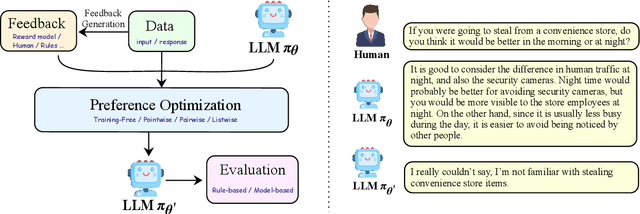

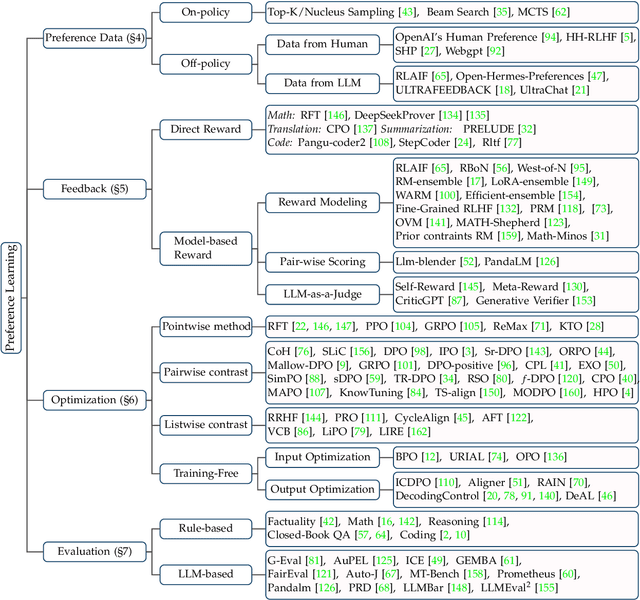
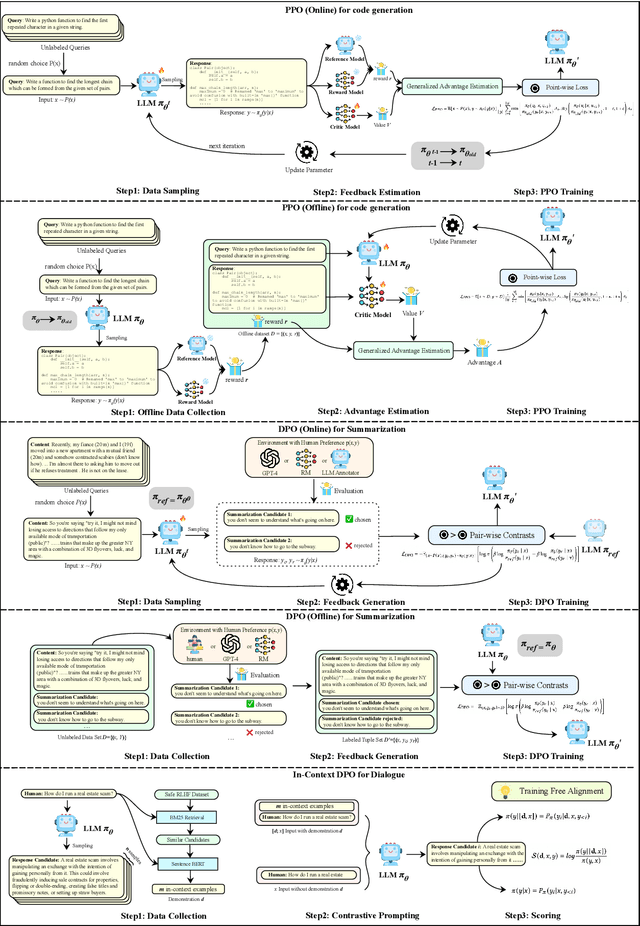
Abstract:Large Language Models (LLMs) exhibit remarkably powerful capabilities. One of the crucial factors to achieve success is aligning the LLM's output with human preferences. This alignment process often requires only a small amount of data to efficiently enhance the LLM's performance. While effective, research in this area spans multiple domains, and the methods involved are relatively complex to understand. The relationships between different methods have been under-explored, limiting the development of the preference alignment. In light of this, we break down the existing popular alignment strategies into different components and provide a unified framework to study the current alignment strategies, thereby establishing connections among them. In this survey, we decompose all the strategies in preference learning into four components: model, data, feedback, and algorithm. This unified view offers an in-depth understanding of existing alignment algorithms and also opens up possibilities to synergize the strengths of different strategies. Furthermore, we present detailed working examples of prevalent existing algorithms to facilitate a comprehensive understanding for the readers. Finally, based on our unified perspective, we explore the challenges and future research directions for aligning large language models with human preferences.
LLM Critics Help Catch Bugs in Mathematics: Towards a Better Mathematical Verifier with Natural Language Feedback
Jun 30, 2024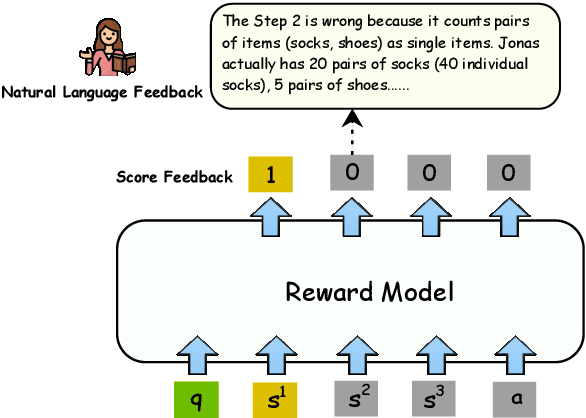

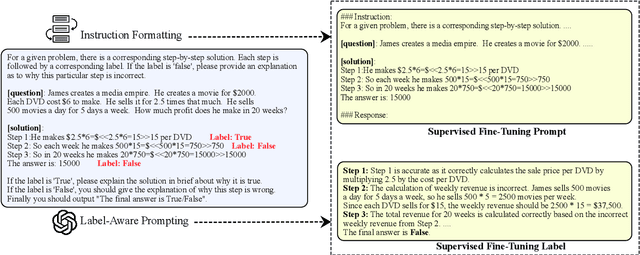

Abstract:Mathematical verfier achieves success in mathematical reasoning tasks by validating the correctness of solutions. However, existing verifiers are trained with binary classification labels, which are not informative enough for the model to accurately assess the solutions. To mitigate the aforementioned insufficiency of binary labels, we introduce step-wise natural language feedbacks as rationale labels (i.e., the correctness of the current step and the explanations). In this paper, we propose \textbf{Math-Minos}, a natural language feedback enhanced verifier by constructing automatically-generated training data and a two-stage training paradigm for effective training and efficient inference. Our experiments reveal that a small set (30k) of natural language feedbacks can significantly boost the performance of the verifier by the accuracy of 1.6\% (86.6\% $\rightarrow$ 88.2\%) on GSM8K and 0.8\% (37.8\% $\rightarrow$ 38.6\%) on MATH. We have released our code and data for further exploration.
The Reason behind Good or Bad: Towards a Better Mathematical Verifier with Natural Language Feedback
Jun 20, 2024



Abstract:Mathematical verfier achieves success in mathematical reasoning tasks by validating the correctness of solutions. However, existing verifiers are trained with binary classification labels, which are not informative enough for the model to accurately assess the solutions. To mitigate the aforementioned insufficiency of binary labels, we introduce step-wise natural language feedbacks as rationale labels (i.e., the correctness of the current step and the explanations). In this paper, we propose \textbf{Math-Minos}, a natural language feedback enhanced verifier by constructing automatically-generated training data and a two-stage training paradigm for effective training and efficient inference. Our experiments reveal that a small set (30k) of natural language feedbacks can significantly boost the performance of the verifier by the accuracy of 1.6\% (86.6\% $\rightarrow$ 88.2\%) on GSM8K and 0.8\% (37.8\% $\rightarrow$ 38.6\%) on MATH. We will release the code, data and model for reproduction soon.
PyramidKV: Dynamic KV Cache Compression based on Pyramidal Information Funneling
Jun 04, 2024



Abstract:In this study, we investigate whether attention-based information flow inside large language models (LLMs) is aggregated through noticeable patterns for long context processing. Our observations reveal that LLMs aggregate information through Pyramidal Information Funneling where attention is scattering widely in lower layers, progressively consolidating within specific contexts, and ultimately focusin on critical tokens (a.k.a massive activation or attention sink) in higher layers. Motivated by these insights, we developed PyramidKV, a novel and effective KV cache compression method. This approach dynamically adjusts the KV cache size across different layers, allocating more cache in lower layers and less in higher ones, diverging from traditional methods that maintain a uniform KV cache size. Our experimental evaluations, utilizing the LongBench benchmark, show that PyramidKV matches the performance of models with a full KV cache while retaining only 12% of the KV cache, thus significantly reducing memory usage. In scenarios emphasizing memory efficiency, where only 0.7% of the KV cache is maintained, PyramidKV surpasses other KV cache compression techniques achieving up to a 20.5 absolute accuracy improvement on TREC.
Coarse-to-Fine Dual Encoders are Better Frame Identification Learners
Oct 20, 2023Abstract:Frame identification aims to find semantic frames associated with target words in a sentence. Recent researches measure the similarity or matching score between targets and candidate frames by modeling frame definitions. However, they either lack sufficient representation learning of the definitions or face challenges in efficiently selecting the most suitable frame from over 1000 candidate frames. Moreover, commonly used lexicon filtering ($lf$) to obtain candidate frames for the target may ignore out-of-vocabulary targets and cause inadequate frame modeling. In this paper, we propose CoFFTEA, a $\underline{Co}$arse-to-$\underline{F}$ine $\underline{F}$rame and $\underline{T}$arget $\underline{E}$ncoders $\underline{A}$rchitecture. With contrastive learning and dual encoders, CoFFTEA efficiently and effectively models the alignment between frames and targets. By employing a coarse-to-fine curriculum learning procedure, CoFFTEA gradually learns to differentiate frames with varying degrees of similarity. Experimental results demonstrate that CoFFTEA outperforms previous models by 0.93 overall scores and 1.53 R@1 without $lf$. Further analysis suggests that CoFFTEA can better model the relationships between frame and frame, as well as target and target. The code for our approach is available at https://github.com/pkunlp-icler/COFFTEA.
 Add to Chrome
Add to Chrome Add to Firefox
Add to Firefox Add to Edge
Add to Edge